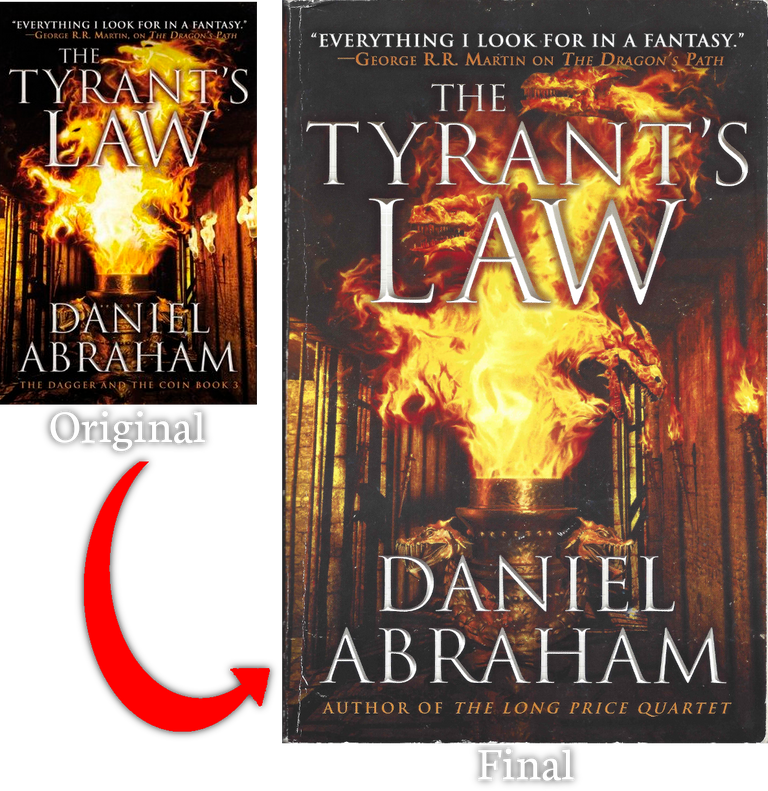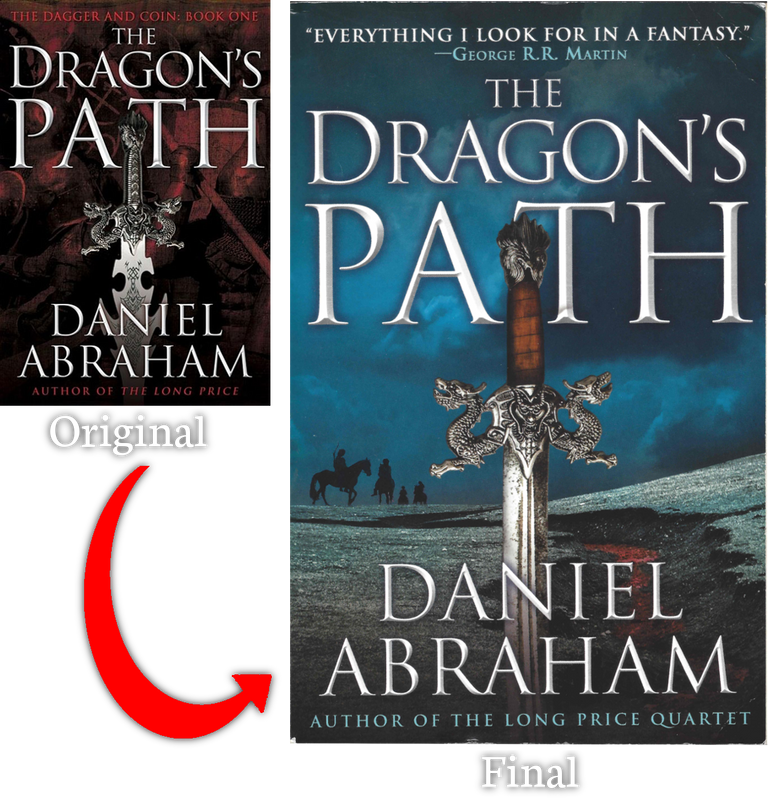Ultimately, my observations come down to a few miscellaneous thoughts and two major critiques.


For the original retrospective, go to here. The retrospective also links to my reviews of the five books that comprise The Dagger and the Coin.

A couple names bear similarity to names in The Long Price Quartet: Issandra from LPQ, and Issandrian from TDatC; similarly, Baarath in LPQ and Barriath in TDatC. Of course, the characters themselves bear no resemblance and in fact Issandra is female whereas Issandrian is male.
Further on the subject of names, many of them resemble each other. It's almost as though there's a recipe for syllables and endings. Observe this list: Kalliam, Palliako, Carvenallin, Daskellin, Skestinin, Issandrian, Bannien, Ischian, Cersillian. Exceptions to these are rather fewer, but more memorable for it: Klin, Broot, Emming, Mecilli, Caot.
I think the names' similarities may have worked against Abraham: in The King's Blood, in the Dramatis Personae at the back of the book, the list of various members of the court of Antea includes, at the end...
Lord Bannien of Estinford
Count Odderd Mastellin
Estin Cersillian, Earl of Masonhalm
Mirkus Shoat, Earl of Rivencourt
and also Houses Flor, Estinford, Faskellan, Emming, Tilliakin, Mastellin, Mecilli, Caot, and Pyrellin, among others
Yes. There is a Lord Bannien of Estinford and there is a Lord Estinford. And Mastellin is listed twice. I suspect both are mistakes.
Not all of the locations on the map are visited - in fact, some of them aren't even mentioned within the story.
A lot of room is left in the ending for a sequel:
- The players are going to Far Syramys, the home of the Haunadam and the Raushadam, which we never meet a single one of in any of the books.
- The Drowned, in An Introduction to the Taxonomy of Races, mentions that "Suggestions that they are tools created toward some great draconic project still in play under the waves it purest romance." However, late in the series, it is confirmed that the Drowned played a part in the final defeat of Morade. (However, they play no real role within the books themselves.)
- Inys is still alive at the end of the book and determined to reclaim the tools used to design the various races of humans and to bring about the rebirth of the dragons. How, exactly, he would reclaim those tools is unknown but poses nothing good for humanity.
- The sleeping Inys was a secret of Order Murro in Hallskar. It begs the question, do other Orders bear unusual or interesting secrets? Is it possible that there might even be another dragon sleeping somewhere?

My one major critique of the series comes down to a lack of world-building. Now, it's not as though it's wholly absent. The similarity in names indicated above shows a common etymological heritage among the Houses populating Antea. Speculative essays, read by Geder, whether it's trees in Northcoast or debates about philosophical questions, are fantastic and deeply interesting.
And there are a scant few mentions of history waiting in the background: At the very end, Geder is coming to be considered "The worst steward the Severed Throne had suffered since Lord Sellandin, eight generations back, and likely worse than he'd been." Earlier in the series, it's said that the House of Antea united the various warring fiefdoms and kingdoms. At some point, houses of Antea and Asterilhold inter-married, hoping to create a closer bond. (This is important background for much of the plot of The Dragon's Path.)
The city of Carse bears a wide, open design indicating that it originally was a city of the dragons, not of humans. There is the war in which Marcus lost his wife and daughter to the fire, in which Lord Springmere became known as "the Mayfly King."
But otherwise there is almost nothing. Geder's mother is never named within the series, even though her absence had tangible consequences on how his father raised him. Dawson, it seems, doesn't have any siblings. Neither of his parents are even so much as mentioned. King Simeon's parents are never named, the ancient ancestor that united the country never named. Prince Aster's mother (and therefore Simeon's wife) is never even mentioned, much less named.
We see tragically little of the structures of other countries. Birancour has a Queen, never named. Northcoast has a King, which we do see and even meet. The Haaverkin and Hallskar, with their Orders and their High Council, are one of the few examples of solidly tangible world-building.
Beyond that there are a bunch of countries of which we know nothing. Which, mind, isn't a problem on its own.
But we spend five books in Antea, and yet there are no historical Kings of import, no myths or legends of great import, no historical figures of any kind that are ever mentioned or even so much as indicated to exist. Nor are there any such things in Northcoast or Birancour. (Even in LPQ, we had occasional mention of statues of emperors of the old empire, and the names of those emperors.)
Thus the name of this section: A World Without History. Of the Dragon Empire, we are only ever given four names: Inys, whom we actually meet; his clutch-mate Eryx, his mad brother Morade, and another brother, Asteril, who crafted the Timzinae.
In between the fall of the Dragon Empire and the events of the series, thousands of years passed. And yet, somehow, nothing worth remembering seems to have happened; or at least, if it did, we never see any indication of it.
The world of a fantasy novel need not have the extensive worldbuilding of JRR Tolkien or even Brandon Sanderson. George R.R. Martin once put it that you can get by with only creating a little bit, and then using that to act as the "10% of the iceberg that's above water." (Not a quote of Martin's.) But in The Dagger and the Coin we do not get even 10% of an iceberg. More like 2%.
This critique is, of course, highly subjective and many will disagree. That is fine.

My second critique is again subjective, but... in my opinion, Orbit did not do a very good job of presenting The Dagger and the Coin.
Firstly, each book was only ever released in tradeback. There were never any paperback releases or any hardcover releases. (I am the sort of person who will only purchase tradeback or hardcover.) The names for the series are, um, not particularly memorable (Spider's War excepted) and take a bit of time to start remembering which order they go in because they are generic.
Secondly, their covers, as you can see above, are less than exceptional. They are somewhat bland and generic, and the usage of weapons on the front covers say very little about the series. Within this the covers for Tyrant's Law and Spider's War are inconsistent. They keep the usage of distinctive colors, but Tyrant's Law adopts this cauldron-y thing with fire coming out of it cross-faded to ugly CG dragons. (The original version used... well, here, I'll show you.)

On the subject of the original cover design for The Dragon's Path, I am somewhat... well, I'm divided. The choice of bold colors was a distinctive one and, therefore, in my opinion, a good one. The original Dragon's Path cover did not have a distinctive, bold color.

You surely can see now why I am divided. The hilt of the blade is kept while the blade itself (ha ha!) is different. The original blade is a bit too fantastical. But in other respects the original was superior. The muted artwork in the background. But a muted cover doesn't grab the attention as well.
And both share the same issue - neither the sword nor muted marching medieval men-in-metal really have much to do with Abraham's series, which is not what you'd call action-packed. It is a choice I understand, even though I wish very badly that they could simply have brought on Stephan Martiniere who did the covers for LPQ.
Thirdly, the descriptions on the back cover are also similarly misleading. Where the covers, at least, created a distinctive identity for the series (as much as I would've loved to see Martiniere's painting of Camnipol and the Division and the Kingspire), the back covers have no such excuse.
ALL PATHS LEAD TO WAR...
MARCUS's hero days are behind him. He knows too well that even the smallest war still means somebody's death. When his men are impressed into a doomed army, staying out of a battle he wants no part of requires some unorthodox steps.
CITHRIN is an orphan, ward of a banking house. Her job is to smuggle a nation's wealth across a war zone, hiding the gold from both sides. She knows the secret life of commerce like a second language, but the strategies of trade will not defend her from sword.
GEDER, sole scion of a noble house, has more interest in philosophy than in swordplay. A poor excuse for a soldier, he is a pawn in these games. No one can predict what he will become.
Falling pebbles can start a landslide. A spat between the Free Cities and the Severed Throne is spiraling out of control. A new player rises from the depths of history, fanning the flames that will sweep the entire region into the Dragon's Path---the path to war.
Strictly speaking none of this is inaccurate. But within the novel itself, the "new player" - the spider priests - in fact bring about a sort of peace, though it does not last. The construction of Geder's section just seems weak at the micro-level of sentence structure. And, of course, it doesn't mention Dawson at all.
That said, "Falling pebbles can start a landslide" is an amazing opening sentence for the last paragraph.
Remaining back covers do spoil certain aspects of plot for those who have not read previous books and even for aspects of the story within the book (though thankfully nothing too severe as those aspects are kept vague.)
Finally: though the books have a wide spine, they are not that long of books. Expansive margins and a large font size balloon the page count to 500+ when each volume likely could've fit into the same page count as a volume of LPQ. (Though as both LPQ and Paul Kearney's work show, it seems that epic fantasy with small spines doesn't seem to sell well...)
Orbit's inability to create a truly strong and memorable presentation of Dagger and the Coin is unusual because they have an extraordinary ability to come up with distinctive branding for their writers; whether those writers are their own or those writers are coming to them from another publisher, their books re-released through them. (Abercrombie stands out as an example of the latter, with Orbit creating new and very distinctive covers for his First Law trilogy.)
What could be done to improve presentation, were the decision to re-release the series ever taken?
- The commissioning of new and more distinctive cover art.
- Instead of ballooning the pagecount artificially by clever playing with margins and font sizes, fit it into the size of volume it belongs in naturally.
- Release it in both hardcover and paperback.
- Maybe rewrite the back cover so it sounds a bit more unique?
And with that my sabbatical from mainstream fantasy begins. I look forward to reading and enjoying many more unusual fantasy works (reading and re-reading Roger Zelazny, reading Susanne Clarke), reading some "literary" fiction and even - yes! - some science fiction, too.
Well of course I cannot read this one either Terry!
But guess what?!
THEY CAME!!!!
Hurray! I hope you enjoy them. :) Daniel Abraham's my favorite writer of all time right now. His way of developing characters, his philosophy of "the biggest moments are most powerful when they're the smallest in scale," it hits all my sweet spots for literature.
Chanting your name really worked, and by incredible coincidence your newest article was about this series! But its probably going to be until the end of the year before I can really read your critiques....
The library has to being them in from offsite, and so it takes about 2 weeks to get them and I only have 3 weeks to read each one. I got two this time though so I will have to finish both before the 12th of Sept...it adds a ticking clock to an already exciting read...so far Geder is my favortite!
Congratulations @terry93d! You have completed the following achievement on Steemit and have been rewarded with new badge(s) :
Click on the badge to view your Board of Honor.
If you no longer want to receive notifications, reply to this comment with the word
STOPDo not miss the last post from @steemitboard:
SteemitBoard and the Veterans on Steemit - The First Community Badge.
This post was shared in the Curation Collective Discord community for curators, and upvoted and resteemed by the @c-squared community account after manual review.